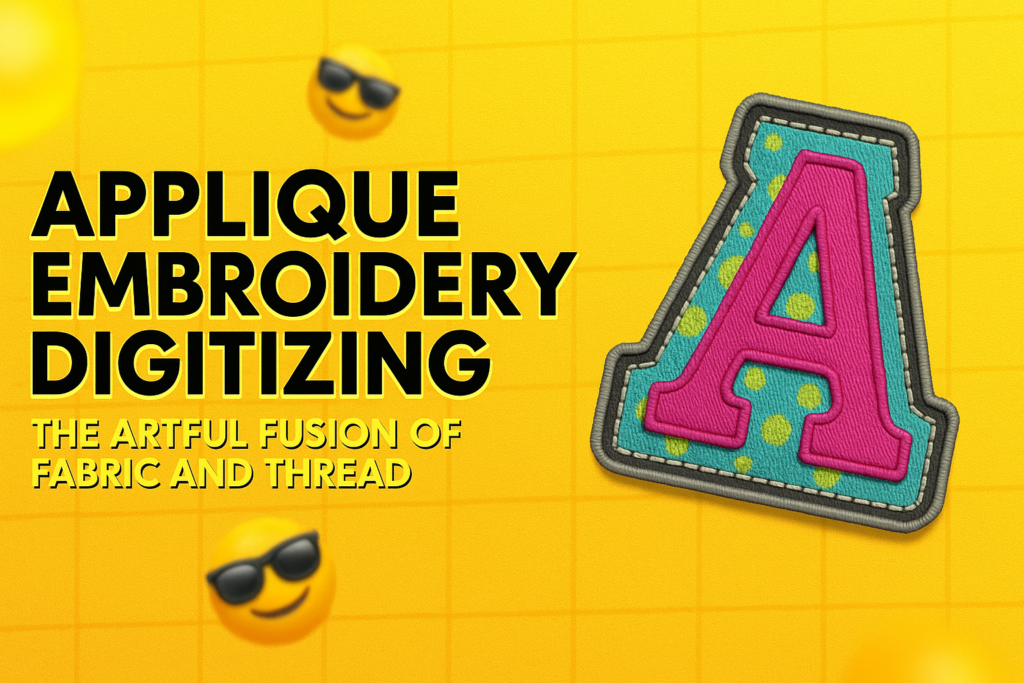In the ever-evolving world of textile design, applique embroidery digitizing is where tradition meets innovation. It’s a technique that marries creativity with technology, offering stunning visual results while also streamlining the embroidery process. Whether you’re a professional digitizer, an embroidery business owner, or a curious crafter, understanding applique digitizing is a game-changer for producing intricate, eye-catching designs with efficiency.
What is Applique Embroidery Digitizing?
At its core, applique embroidery involves stitching a piece of fabric onto a larger base fabric, creating patterns or designs with layered textiles. When digitizing is added to the equation, the process is translated into a digital format using embroidery software, allowing machines to execute the design with precision.
Applique embroidery digitizing simplifies the manual workload and opens doors to more complex designs, perfect alignment, and faster production.
Why Applique Digitizing is Gaining Popularity
The modern embroidery landscape demands speed, precision, and visual impact. Applique embroidery meets all three. Here’s why it’s making waves:
- Cost-effective: Less thread usage means lower production costs.
- Time-saving: Machines complete designs faster, especially large ones.
- High visual impact: The use of contrasting fabrics can make designs pop.
- Eco-friendly: Reduces thread waste, especially on larger surfaces.
The Applique Digitizing Process: Step by Step
If you’re considering integrating applique into your embroidery business, understanding the digitizing process is key. Here’s how it works:
1. Design Planning
Before digitizing, a design is planned carefully—deciding where fabrics will be placed, the size and shape of each applique piece, and the overall layout. Clarity in this stage saves time during digitization and stitching.
2. Creating Placement Stitch
This is the first stitch in the digitized file. It tells the machine where the applique fabric will go. It’s usually a simple running stitch outlining the area.
3. Manual Fabric Placement
Once the placement stitch is done, fabric is laid over the outlined area manually.
4. Tack Down Stitch
Next, the machine sews a tack down stitch, securing the fabric in place. Excess fabric is trimmed away for clean edges.
5. Final Satin or Decorative Stitch
Finally, the machine applies a satin stitch or decorative border around the applique to seal the design and add a polished finish.
6. Finishing Touches
Sometimes, small embroidered details are added on top of the applique for depth and complexity.
Tools and Software for Applique Digitizing
To create accurate and attractive applique embroidery, you’ll need the right digitizing software. Popular choices include:
- Wilcom Embroidery Studio
- Hatch by Wilcom
- Brother PE-Design
- Embird
- Bernina ArtLink
Each of these programs provides features like layering, stitch editing, and previewing to help digitizers perfect their applique designs.
Best Practices for Applique Embroidery Digitizing
Want your applique embroidery designs to stand out and stitch out smoothly? Follow these tips:
1. Use High-Quality Fabrics
Thin or fraying fabrics can cause issues during stitching. Choose materials that can hold up to trimming and stitching.
2. Test Runs are Essential
Always do a test stitch on scrap fabric. This helps catch any misalignments or design issues before full production.
3. Digitize with Precision
Ensure your placement, tack down, and final stitches align perfectly. Even a slight miscalculation can affect the final outcome.
4. Layer Wisely
If your design includes multiple layers of applique, plan your sequence to avoid puckering and uneven stitching.
5. Trim Excess Carefully
A clean trim ensures a neat final appearance. Scissors or tools made specifically for applique trimming are highly recommended.
Applique Embroidery Trends in 2025
As of this year, applique is trending not just in traditional wear but also in fashion-forward garments, streetwear, baby apparel, and home décor. Mixed media applique—using felt, leather, or even sequins—is becoming more popular, making digitizing skills all the more valuable.
Eco-conscious embroidery is also on the rise. Using leftover fabric for applique is a sustainable way to reduce textile waste.
Common Mistakes in Applique Digitizing (And How to Avoid Them)
Like any craft, applique embroidery digitizing comes with a learning curve. Here are a few common pitfalls:
- Wrong stitch density – Too dense and the fabric puckers; too loose and it unravels.
- Poor fabric choice – Avoid overly stretchy or thin fabrics unless stabilized properly.
- Lack of stabilization – Always use the right backing material to support your design.
- Ignoring software previews – Most digitizing programs show you how your design will stitch. Always preview!
SEO Tips for Applique Embroidery Digitizing Businesses
If you run a business offering applique digitizing services, ranking on search engines is crucial. Here are some SEO best practices:
- Targeted Keywords: Use phrases like applique embroidery digitizing, custom applique digitizing, or machine applique services in your titles, headers, and content.
- Long-Form Content: Like this blog, long-form content provides in-depth value and performs better in search results.
- Optimized Images: Include high-resolution images of your designs with descriptive alt tags (e.g., “applique embroidery design of floral pattern”).
- Local SEO: If you offer local services, optimize for local search by including your location in titles and metadata.
- Internal Linking: Link to other relevant pages on your site like service pages, pricing, FAQs, or client testimonials.
Applique Digitizing is the Future of Creative Embroidery
Applique embroidery digitizing is more than just a niche technique—it’s a powerful tool for creating visually rich, cost-effective designs that blend traditional fabric art with cutting-edge technology. Whether you’re a beginner or a seasoned pro, mastering applique digitizing opens up new avenues of creativity and business potential.
As digitizing software evolves and fashion trends continue to embrace personalized, textured designs, applique embroidery is poised to remain a top choice for crafters and businesses alike.
Ready to elevate your embroidery game? Dive into the world of applique digitizing—you’ll be stitching brilliance in no time.







